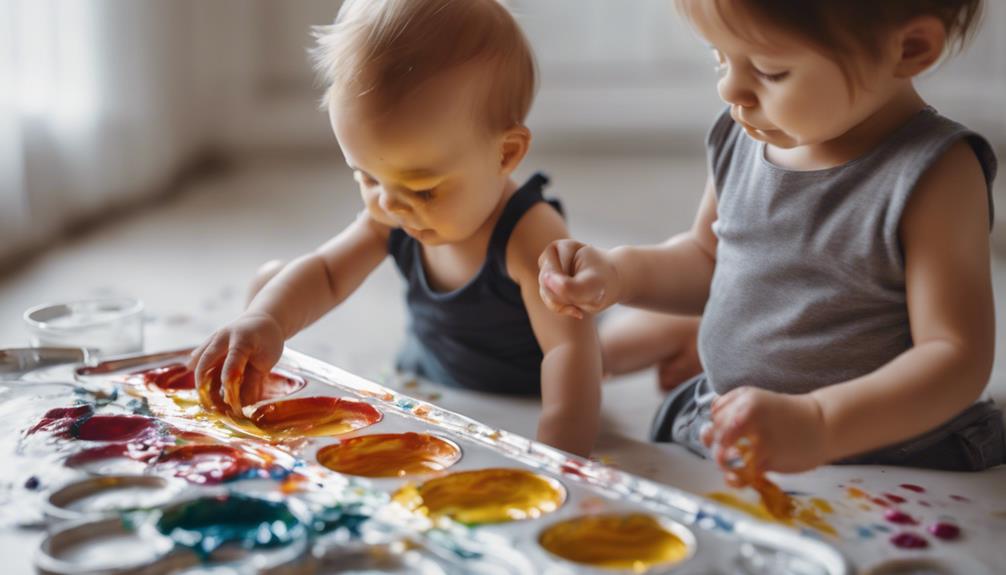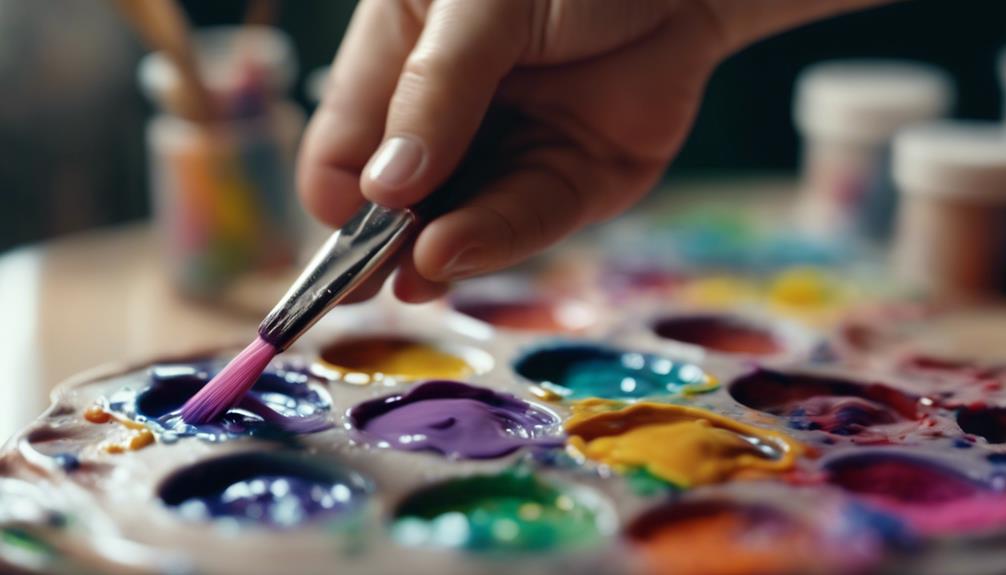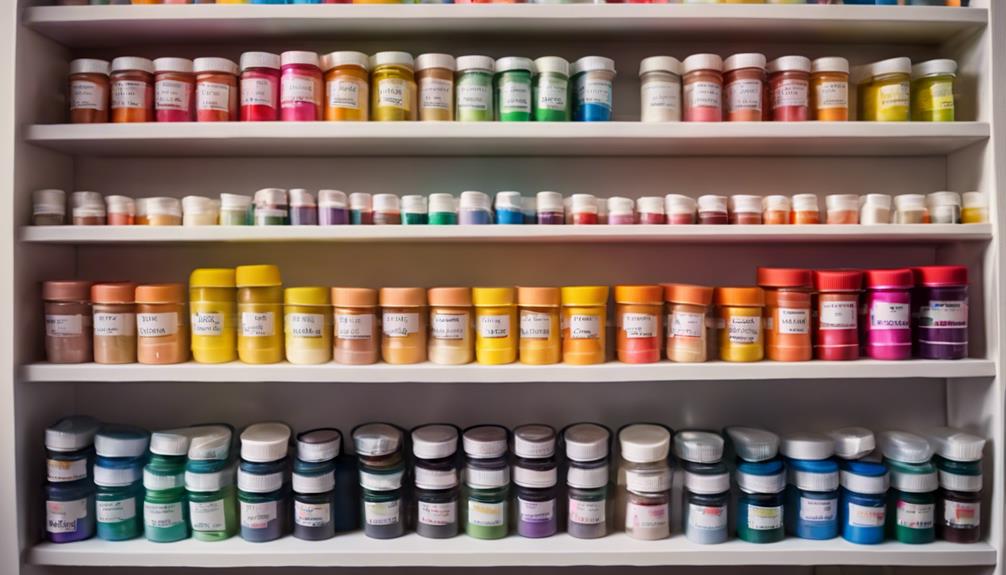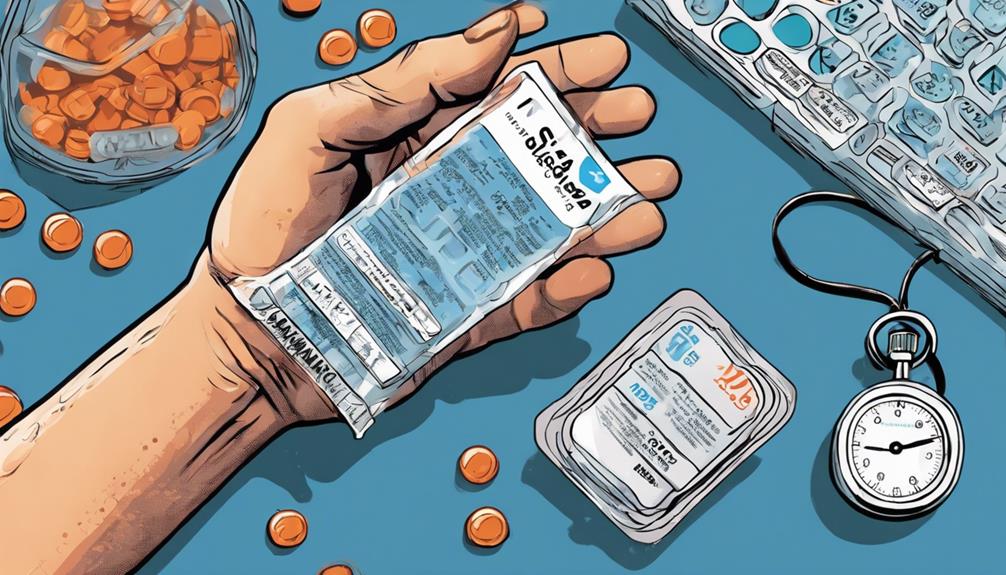Embark on a safe artistic journey with taste-safe finger paint for babies. Opt for mess-free foil painting activities using edible yogurt-based paint and crumpled tin foil. Venture into visually stunning metallic paint with luster dust for a shiny finish. Explore unconventional paintbrush materials like feathers and vegetables for unique effects. Remember to store edible paint in an airtight container for best freshness. These activities stimulate creativity, fine motor skills, and sensory play, making them ideal for little ones. Uncover a world of colorful possibilities and secure exploration with these engaging baby-safe finger paint ideas.
Key Takeaways
- Taste-safe finger paint recipe for worry-free exploration.
- Mess-free foil painting activity for sensory play.
- Edible metallic paint instructions for visual appeal.
- Creative paintbrush ideas using unconventional materials.
- Storage tips for maintaining edible paint freshness.
Taste-Safe Finger Paint Recipe
To create taste-safe finger paint for your baby, combine flour, salt, water, and food coloring in a mixing bowl. This edible finger paint recipe is perfect for your little ones to explore art in a safe and sensory way.
The homemade paint provides a fantastic opportunity for your baby to engage in fine motor activities while stimulating their creativity. Edible finger paint isn't only safe but also encourages color recognition and enhances sensory play. The neutral taste of this paint allows your baby to explore without any concerns, and you can even add flavorings if desired.
Using this taste-safe paint, your baby can enjoy a mess-free painting experience while developing their artistic skills. This sensory activity isn't only entertaining but also beneficial for your baby's cognitive and motor development. So, whip up a batch of this safe and edible finger paint, and watch your baby delight in the colorful world of art.
Mess-Free Foil Painting Activity

Engage your baby in a messy yet enjoyable sensory activity with baby foil painting using crumpled tin foil and safe, edible yogurt-based finger paint. This mess-free art project is perfect for sensory play, encouraging your little one's creativity and exploration.
Simply crumple a piece of tin foil to create a textured canvas for your baby to explore. Prepare baby-safe edible paint by mixing yogurt with food coloring to make sure it's safe for little hands and mouths. Set up this activity during tummy time or in a high chair for easy access.
Watch as your baby dips their fingers and toes in the colorful paints, creating unique artwork on the foil. Baby foil painting not only provides a fun and engaging experience but also supports childhood development through sensory stimulation.
Capture the joy of messy play while keeping it safe and enjoyable for your little artist.
Edible Metallic Paint Instructions

Create visually stunning metallic paint using food-grade ingredients and luster dust for safe and engaging sensory play with your little ones.
To make this edible metallic paint at home, start with a base recipe for homemade finger paint using food coloring and other edible materials. Once you have your base ready, gradually mix in luster dust until you achieve the desired metallic effect.
This toddler-safe paint not only offers a creative outlet but also guarantees that your little one can explore colors and textures in a secure manner. The shiny finish of the metallic paint adds an extra dimension to their sensory experience, making artistic projects even more exciting.
With this edible option, you can foster your child's creativity without worrying about any harmful substances.
Engage in various creative activities with your child using this homemade edible metallic paint, providing a fun and safe environment for them to express themselves artistically.
Creative Paintbrush Ideas

Get creative with your paintbrushes by exploring unique and unconventional materials to enhance your baby's sensory painting experience. Instead of traditional brushes, consider using everyday items like cotton balls, sponges, feathers, or even vegetables like celery or broccoli for a fun sensory experience during finger painting sessions.
DIY paintbrush options such as pom-poms, fabric scraps, or bubble wrap can help create unique patterns and effects on the canvas. Encourage exploration and creativity in babies and toddlers by using multiple paintbrushes at once or combining different materials to see the diverse outcomes they produce.
Additionally, incorporating natural elements like leaves, pinecones, or twigs as paintbrushes can introduce a little bit of nature into your little one's artistic endeavors, making the painting process even more engaging and enriching. Take some time to experiment with these creative paintbrush ideas to make each painting session a memorable and enjoyable experience for your child.
Storage Tips for Edible Paint

Properly store edible paint in an airtight container at room temperature to maintain its freshness and effectiveness. Here are some essential storage tips to guarantee your edible paint stays in prime condition:
- Fresh Batches: It's recommended to prepare fresh batches of edible paint to achieve the best outcomes in terms of texture and color.
- Proper Sealing: Ensure the container is tightly sealed to prevent the development of a bad smell in the paint, which can impact its quality.
- Shelf Life: The shelf life of edible paint is up to a week, making it ideal for preparing in advance for events like birthday parties.
After this period, it's advisable to discard any leftover paint and make a new batch for future indoor projects and creative activities.
Frequently Asked Questions
What Does Finger Painting Teach Babies?
Finger painting teaches you sensory exploration, fine motor skills development, creativity, color recognition, cause-and-effect thinking, texture understanding, shape recognition, pattern recognition, hand-eye coordination, and muscle development. It's a fun way for you to express yourself artistically and communicate non-verbally.
How to Make Homemade Paint Safe for Babies?
So, you want to make homemade paint safe for babies? Well, just mix flour, salt, water, and food coloring. Voila! Edible, non-toxic finger paint ready for your little artist's masterpieces. Enjoy the mess!
How to Do Finger Painting Activity?
Gather non-toxic edible finger paint, provide a safe surface, and dress your baby in old clothes. Let them explore and create freely, encouraging sensory development. Capture their masterpieces by transferring onto paper or creating prints for keepsakes.
Is Hand Painting a Sensory Activity?
Yes, hand painting is a sensory activity that engages touch, sight, and sometimes taste. It fosters creativity, develops fine motor skills, and supports brain growth in children. Embrace the mess and watch their imaginations soar!
Conclusion
In the world of baby safe finger paint, creativity knows no bounds. With a few simple ingredients and some imagination, you can create a safe and enjoyable artistic experience for your little one.
Remember, the journey of exploration and discovery is just beginning, so let your creativity flow and watch as your child's artistic abilities flourish.
The possibilities are endless, so grab some paint and let the creativity shine!










